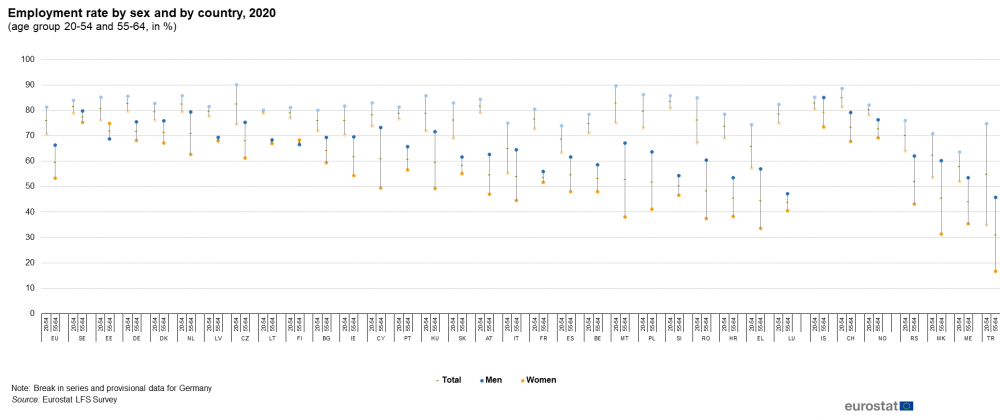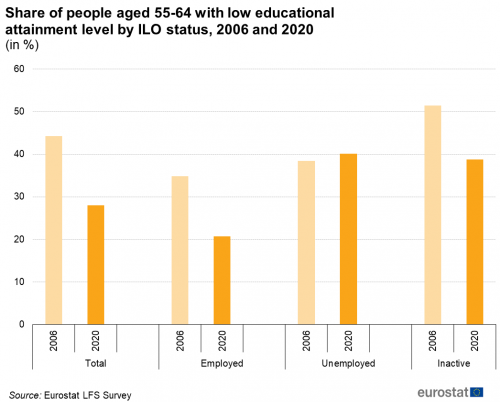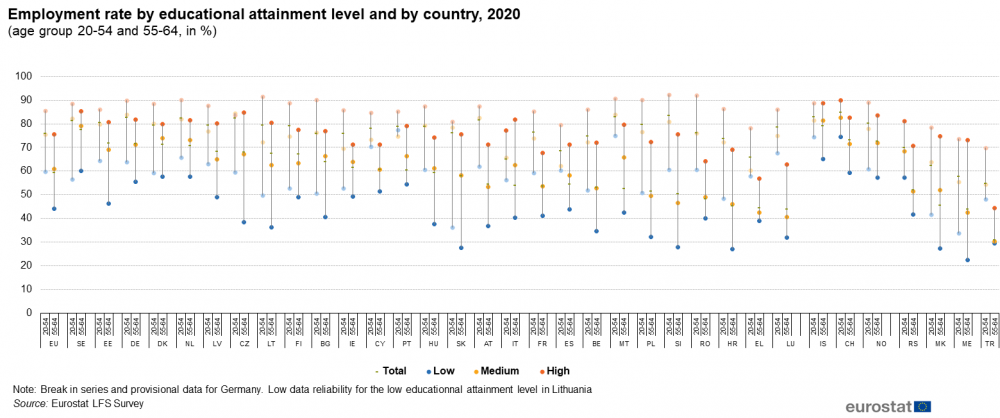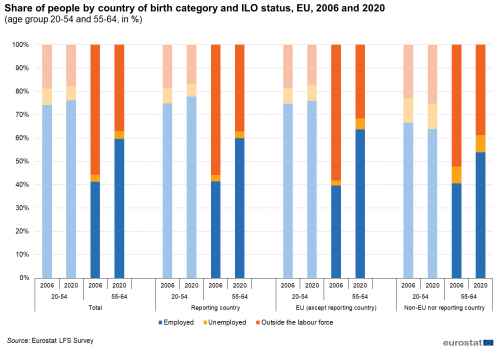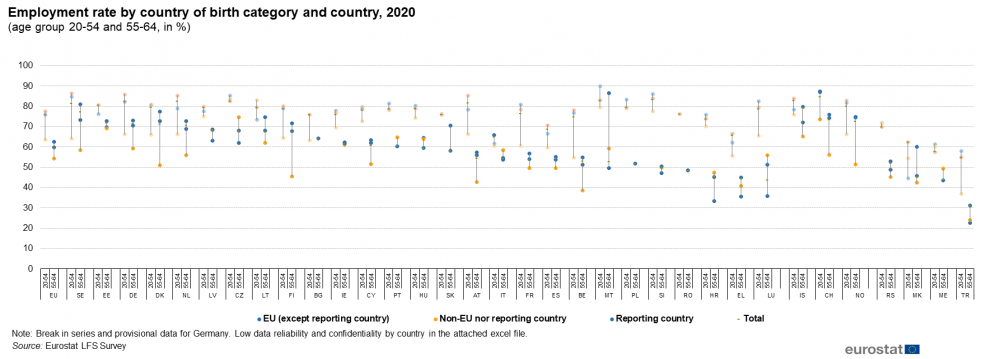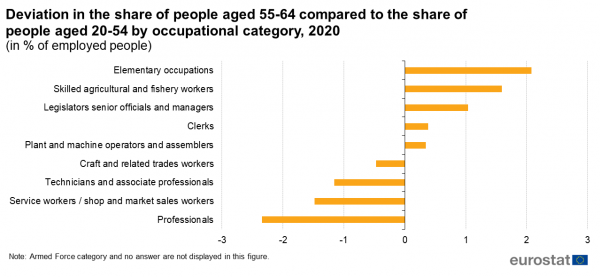Archive:Main differences between older and younger people on the EU labour market - statistics
Data extracted in June 2021
Planned article update: July 2022
Highlights
Tweet Text
Tweet Text
In the European Union (EU), the last two decades have been marked by a steady increase in the employment of people aged 55-64 years. In all EU Member States, the global trend shows that people remain longer in employment, pushing back the age of retirement. The COVID-19 pandemic seems also to have, so far, spared them from mass losses showing an employment rate of people aged 55-64 less fluctuant in 2020 than for younger people. To illustrate simply this development, around four in 10 persons aged 55-64 were employed in the EU in 2006 against six in 10 in 2020.
Using data from the EU Labour Force Survey (EU-LFS), this article focuses on the main differences between older and younger people as regards their labour status, i.e. whether they are employed, unemployed or outside the labour force, and the associated socio-demographic and socioeconomic determinants. In the context of this article linked to the labour market, the groups of younger and older people are defined as people aged 20 to 54 years and people aged 55 to 64 years respectively. The evolution over time, comparing the years 2006 and 2020, is also looked at for the two age groups regarding the possible impact of the socio-demographic characteristics on the labour status. Results are presented for the EU as a whole, but also for all EU Member States individually, for three EFTA countries (Iceland, Norway and Switzerland) and four candidate countries (Montenegro, North Macedonia, Serbia and Turkey).
In addition to descriptive statistics, this article presents results from Chi-square independence tests, as well as from logistic regressions using the socio-demographic and socioeconomic determinants as independent variables and the labour status as dependent variable.
In particular, this article aims to answer the following question: do the older workers have the same profile than younger people, in terms of gender, educational attainment level, country of birth and occupational category?
Full article
Focus on gender
Figure 1 examines the differences at EU level between people aged 20-54 and 55-64 in regards to the labour market, with a focus on gender. Looking at the 20-54 years old population, the rate of employed people increased by 2.0 percentage points (p.p.) from 2006 to 2020, with a decrease of around 1.0 p.p. for the share of unemployed people and the share of people outside the labour force. By contrast, the proportion of employed people among the age group 55-64 grew by 18.4 p.p. from 2006 to 2020, i.e. this age group had a much stronger increase in its employment rate than the younger population. The increase in the employment rate for people aged 55-64 was accompanied by a decrease of 18.7 p.p. in the share of people outside the labour force and a slight increase, of 0.3 p.p., in the share of unemployed people in the 15 years period from 2006 to 2020.
Results in terms of gender show that the labour market situation for men aged 20-54 remained relatively stable between 2006 and 2020, with the largest change between these two years lying in the share of people outside the labour force, which increased by 1.1 p.p. Women had slightly more pronounced difference between 2006 and 2020 regarding the labour market situation. The female employment rate increased by 4.3 p.p., while the share of unemployed women decreased by -1.2 p.p. and the share of women outside the labour force declined by -3.1 p.p.
In contrast, women aged 55-64 had a 20.8 p.p. increase in their employment rate, a 0.5 p.p. increase in their share of unemployed people and a 21.3 p.p. reduction in their share of people outside the labour force from 2006 to 2020. Men in the age group 55-64 experienced smaller changes in comparison with their female counterparts. However, the evolutions were still significantly larger for men aged 55-64 than for men aged 20-54. Considering the age group 55-64, the male employed population increased by 15.9 p.p. from 2006 to 2020, the decrease in the share of men outside the labour force had exactly the same size (15.9 p.p.), while the share of unemployed men remained stable over that period.
Despite the much more pronounced increase between 2006 and 2020 in the employment rate for people aged 55-64 in comparison with those aged 20-54, those two shares could not even out. In 2020, 76.2 % of people aged 20-54 were employed in the EU. With 59.6 %, the equivalent share for the older population, i.e. those aged 55-64, was still significantly smaller. Among the younger men, aged 20-54, 81.4 % were employed, compared with 66.2 % for the older male population. Although the employment rate for women in both age groups (20-54 and 55-64) was smaller than men’s, the same pattern can be witnessed: larger share for the younger age group in comparison with the older (70.8 % versus 53.4 %).
In all EU Member States in 2020, the employment rate for people aged 20-54 was larger than for people aged 54-64 (see Figure 2). Nevertheless, the generational gap varied a lot: from less than 10 p.p. in Estonia (8.8 p.p.), Denmark (8.2 p.p.) and Sweden (4.0 p.p.) to more than 30 p.p. in Malta (30.2 p.p.), Slovenia (33.1 p.p.) and Luxembourg (34.8 p.p.). In addition, the highest employment rate for people aged 55-64 was recorded namely in Sweden (77.6 %), Estonia (72.0 %) and Denmark (71.4 %). Germany, with 71.8 %, also had one of the largest employment rates for the age group 55-64 (however, the 2020 German data are still provisional). In contrast, Luxembourg registered the lowest employment rate in the EU for people in that age group - 44.0 %. In Romania, Croatia and Greece, also less than 50 % of the total population aged 55-64 were employed. Higher employment rates were found for the age group 20-54 in both ends of the scale, ranging from 83.6 % in Slovenia, 83.1 % in Malta and 82.8 % in Germany to 68.9 % in Spain, 66.0 % in Greece and 65.2 % in Italy.
Another relevant finding is that the gender gap in employment appears to be larger among people aged 55-64 than among those aged 20-54. In the age group 20-54, a larger employment rate was recorded for men than for women in all Member States, and the gap reached 17.0 p.p. in Greece, 17.7 p.p. in Romania and 19.7 p.p. in Italy. By contrast, for the age group 55-64, while the male employment rate surpassed the female one in 25 out of the 27 EU Member States, the gap exceeded 20 p.p. in six Member States: Hungary (22.4 p.p.), Poland (22.6 p.p.), Romania (22.9 p.p.), Greece (23.4 p.p.), Cyprus (23.9 p.p.) and Malta (29.1 p.p.). Finland and Estonia were the only EU countries with a larger employment rate for women than for men in the age group 55-64 (gender gaps of 1.8 p.p. and 6.1 p.p. respectively for those two countries).
Focus on education
At EU level, the share of people with a low level of education among the total employed population aged 55-64 decreased significantly from 2006 to 2020, from 34.9 % to 20.7 % (see Figure 3). This share among those outside the labour force was larger than among the employed population; however, it also had a significant decrease for the same period - from 51.5 % to 38.7 %. The only group of people in terms of labour market status, which saw an increase in the share of people with a low level of education was that of unemployed; among the total unemployed people aged 55-64, 38.4 % were with low education in 2006, and 40.1 % in 2020.
Figure 4 reveals that at EU level people aged 55-64 needed a level of education further to reach a similar level of employability as those aged 20-54. In 2020, the employment rate for older people (aged 55-64) with a medium level of education was 60.9 %, similar to the rate for younger people (aged 20-54) with low education, which was 59.9 %. Analogically, older people with a high level of education had a similar employment rate as young people with medium education (75.6 % compared with 75.7 %). Furthermore, considering the educational levels separately, younger people had a significantly higher employment rate than the older generation in all the three levels shown in Figure 4. Precisely, the rate in 2020 for people aged 20-54 was higher than the rate for those aged 55-64 with 15.8 p.p., 14.8 p.p. and 10.1 p.p., respectively for the population with a low, medium and high level of education.
The development in the labour market situation from 2006 to 2020 for people with a low level of education had a different direction for age group 20-54 and 55-64, particularly as regards employment. The share of employed among the total population aged 20-54 with low education dropped during this period by 4.6 p.p., accompanied by a 1.4 p.p. and 3.2 p.p. increase in the share of unemployed and those outside the labour force. At the same time, the employment rate for people aged 55-64 with a low level of education increased by 11.6 p.p., the unemployment also increased, by 2.1 p.p., suggesting that more people in this sub-population began to seek job and were available to work when 2006 and 2020 are compared, in addition, the share of people outside the labour force contracted by 13.6 p.p.
Considering the different levels of education, the employment rate increased the most from 2006 to 2020 for those aged 55-64 with a medium level of education, precisely by 18.5 p.p. The population aged 20-54 with the same level of education also had an increase in the employment rate during this period, however, the size of the increase was significantly smaller, only by 1.5 p.p. Focusing on tertiary education graduates, i.e. those with a high level of education, older people also had a larger change in the employment rate than the younger, the rate for people aged 55-64 increased by 13.4 p.p., while it slightly decreased for people aged 20-54, by 0.1 p.p.
Education and age appear to play a huge role in determining whether or not a person is employed, as the highest employment rates in the EU can be found for younger people, aged 20-54, with a high level of education, reaching 92.2 % in Slovenia, 91.9 % in Romania and 91.5 % in Lithuania. Malta, Bulgaria, Poland and the Netherlands, also had an employment rate for this sub-population exceeding 90 %. On the opposite side of the scale, the lowest employment rates can be observed for the population aged 55-64 with a low level of education. The bottom values for this sub-population were found in Slovenia (27.8 %), Slovakia (27.5 %) and Croatia (27.2 %). This information is displayed in the figure below, Figure 5.
Focus on country of birth
Starting with the development between 2006 and 2020, the figure 6 shows that share of employed people aged 55-64 who were born in the reporting country increased by 18.6 p.p. reaching 60.0 % in 2020. This increase is nevertheless lower than for older worker who were born in another EU country going up from 39.7 % in 2006 to 63.6 % in 2020 (+24.0 p.p. due to rounding). With respect to people aged 55-64 who were born outside the EU (neither in the reporting country nor in another EU member States), the share of employed people also increased but in a lesser extent (+ 13.4 p.p.). Comparing these changes to those observed among younger people, it shows that the increase has been higher for people who were born in the reporting country than for those who were born in another EU Member States or outside the EU (respectively +2.8 p.p. against +1.1 p.p. and -2.7 p.p.). About unemployed people aged 55-64, it also increased more for people aged 55-64 who were born in another EU Member States (+2.7 p.p.) than for people who were born in the reporting country (+0.2 p.p.) and people who were born outside the EU (+0.1 p.p.).
In 2020, the main differences among the two age groups i.e. people aged 55-64 and people aged 20-54 are higher for people who were born in the reporting country (17.7 p.p.) than for people who were born in another EU Member States (12.2 p.p.) or in a country outside the EU (10.0 p.p.).
Even if at EU level, the employment rate of people aged 55-64 who were born in another EU Member States is higher than the employment rate of those born in the reporting country, this situation is observed in less than half of the EU Member States where in most countries, the employment rate of people born the reporting country is higher.
Main differences between age groups are shown in Figure 7. The largest differences for people who were born in the reporting country are reported for Luxembourg where the employment rate of younger people is 43.7 p.p. above the one reported for people aged 55-64 followed by Malta and Slovenia with around 38 p.p. of difference. Among people who were born in another EU Member States, the largest differences between both age groups are reported by Croatia, Slovenia and Luxembourg with a gap of more than 30 p.p.
Largest differences between both age groups are not so large considering the employment rate of people who were born outside the EU. However, the largest differences were recorded in Austria, Lithuania, Cyprus and Malta which reported gap between 20 p.p. and 24 p.p. between both younger and older people.
Focus on occupational category
Looking at the distribution people aged 55-64 shown in Figure 8, it appears almost one in five employed persons aged 55-64 is part of the professionals category (19.9 %). This category encompasses people working as professionals in various domains: science and engineering, health, teaching, business and administration, information and communications technology and finally, in legal, social and cultural fields, and generally with a high skill level (for further information see the ISCO-08 structure). Technicians and associate professionals amounted for 15.8 % of the total of employed persons and to complete the top 3 of the occupational categories, the service workers and, shop and market sales workers that gathered in 2020 14.5 % of the total of workers aged 55-64.
In order to compare the distribution of employed people aged 55-64 across occupational categories with the distribution of people aged 20 to 54, Figure 9 displays the differences in the shares of employed people aged 55-64 with those reported for people aged 20-54 at EU level. Chi-square independence test shows that we can reject the hypothesis that there is no link between occupational category and age group. This means that it is very likely that people aged 55-64 does not follow the same distribution as people aged 20-64. Based on Figure 9, one can see that the share of older worker with elementary occupations was larger in 2020 than for younger worker (10.0 % against 7.9 %) as well as for skilled agricultural and fishery workers (4.6 % of older workers were in this category against 3.0 % of people aged 20-54). The share of legislators senior officials and managers is also a bit higher for older than younger worker. By contrast, among people aged 20-54, professionals, technicians and associate professionals, service workers and, shop and market sales workers are more prominently represented than for people aged 55-54.
Source data for tables and graphs
Data sources
Source: The European Union Labour Force Survey (EU-LFS) is the largest European household sample survey providing quarterly and annual results on labour participation of people aged 15 and over as well as on persons outside the labour force. It covers residents in private households. Conscripts in military or community service are not included in the results. The EU-LFS is based on the same target populations and uses the same definitions in all countries, which means that the results are comparable between the countries. The EU-LFS is an important source of information about the situation and trends in the national and EU labour markets. Each quarter around 1.8 million interviews are conducted throughout the participating countries to obtain statistical information for some 100 variables. Due to the diversity of information and the large sample size, the EU-LFS is also an important source for other European statistics like Education statistics or Regional statistics.
Reference period: Yearly results are obtained as averages of the four quarters in the year.
Coverage: The results from the survey currently cover all European Union Member States, the EFTA Member States Iceland, Norway and Switzerland, as well as the candidate countries Montenegro, North Macedonia, Serbia and Turkey. For Cyprus, the survey covers only the areas of Cyprus controlled by the Government of the Republic of Cyprus.
European aggregates: EU and EU-27 refer to the totality of the EU of 27 Member States. If data are unavailable for a country, the calculation of the corresponding aggregates takes into account the data for the same country for the most recent period available. Such cases are indicated.
Country note: In Germany, since the first quarter of 2020, the Labour Force Survey (LFS) has been integrated into the newly designed German microcensus as a subsample. Unfortunately, for the LFS, technical issues and the COVID-19 crisis has had a large impact on the data collection processes, resulting in low response rates and a biased sample. Changes in the survey methodology also led to a break in the data series. The published German data are preliminary and may be revised in the future. For more information, see here.
Definitions: The concepts and definitions used in the EU-LFS follow the guidelines of the International Labour Organisation.
Employment covers persons aged 15 years and over (16 and over in Spain and Italy, 15-74 years in Estonia, Latvia, Hungary, Finland, Sweden, Norway and Denmark, and 16-74 years in Iceland), living in private households, who during the reference week performed work, even for just one hour, for pay, profit or family gain, or were not at work but had a job or business from which they were temporarily absent, for example because of illness, holidays, industrial dispute or education and training.
The LFS employment concept differs from national accounts domestic employment, as the latter sets no limit on age or type of household, and also includes the non-resident population contributing to GDP and conscripts in military or community service.
The level of education refers to the educational attainment level, i.e. the highest level of education successfully completed. Low level of education refers to ISCED levels 0-2 (less than primary, primary and lower secondary education), medium level refers to ISCD levels 3 and 4 (upper secondary and post-secondary non-tertiary education) and high level of education refers to ISCED levels 5-8 (tertiary education).
Different articles on detailed technical and methodological information are available through: EU labour force survey.
Context
Employment statistics can be used for a number of different analyses, including macroeconomic (looking at labour as a production factor), productivity or competitiveness studies. They can also be used to study a range of social and behavioural aspects related to an individual’s employment situation, such as the social integration of minorities, or employment as a source of household income.
Employment is both a structural indicator and a short-term indicator. As a structural indicator, it may shed light on the structure of labour markets and economic systems, as measured through the balance of labour supply and demand, or the quality of employment. As a short-term indicator, employment follows the business cycle; however, it has limits in this respect, as employment is often referred to as a lagging indicator.
Employment statistics are at the heart of many EU policies. The European employment strategy (EES) was launched at the Luxembourg jobs summit in November 1997 and was revamped in 2005 to align the EU’s employment strategy more closely to a set of revised Lisbon objectives, and in July 2008, employment policy guidelines for the period 2008–2010 were updated. In March 2010, the European Commission launched the Europe 2020 strategy for smart, sustainable and inclusive growth; this was formally adopted by the European Council in June 2010. The European Council agreed on five headline targets, the first being to raise the employment rate for women and men aged 20 to 64 years old to 75 % by 2020. EU Member States may set their own national targets in the light of these headline targets and draw up national reform programmes that include the actions they aim to undertake in order to implement the strategy.
The European Pillar of Social Rights has been jointly signed by the European Parliament, the Council and the Commission on 17 November 2017. Employment and social policies are the main fields of interest of the European Pillar of Social Rights, which is about delivering new and more effective rights for citizens. It has 3 main categories: (1) Equal opportunities and access to the labour market, (2) Fair working conditions and (3) Social protection and inclusion. In particular, today's more flexible working arrangements provide new job opportunities especially for the young but can potentially give rise to new precariousness and inequalities. Building a fairer Europe and strengthening its social dimension is a key priority for the Commission. The European Pillar of Social Rights is accompanied by a ‘social scoreboard’ which will monitor the implementation of the Pillar by tracking trends and performances across EU countries in 12 areas and will feed into the European Semester of economic policy coordination. The scoreboard will also serve to assess progress towards a social ‘triple A’ for the EU as a whole.
At the Informal meeting of heads of state or government of 7-8 May 2021, EU leaders discussed on the implementation of the European pillar of social rights at EU and national level, as established by the EU strategic agenda 2019-2024. The action plan presented by the Commission in March 2021 provides guidance on the implementation of the European pillar of social rights, including in the areas of employment, skills and social protection. The action plan also sets three main targets to be achieved throughout the European Union by 2030:
- an employment rate of at least 78% in the EU;
- at least 60% of adults attending training courses every year;
- a reduction of at least 15 million in the number of people at risk of social exclusion or poverty.
For more information, see here.
Direct access to
- All articles on employment
- Employment - quarterly statistics
- Employment in detail - quarterly statistics
- Labour market slack - unmet need for employment - quarterly statistics
- Labour market slack – annual statistics on unmet needs for employment
- Unemployment statistics and beyond
- People outside the labour force
- Job vacancy statistics
- Labour market statistics at regional level
- The EU in the world — labour market
- Labour market in the light of the COVID 19 pandemic — online publication
- EU labour force survey — online publication
- Labour force survey in the EU, EFTA, United Kingdom and candidate countries — Main characteristics of national surveys, 2019, 2021 edition
- Quality report of the European Union Labour Force Survey 2019, 2021 edition
- LFS main indicators (t_lfsi)
- Population, activity and inactivity - LFS adjusted series (t_lfsi_act)
- Employment - LFS adjusted series (t_lfsi_emp)
- Unemployment - LFS adjusted series (t_une)
- LFS series - Detailed annual survey results (t_lfsa)
- LFS series - Specific topics (t_lfst)
- LFS main indicators (lfsi)
- Employment and activity - LFS adjusted series (lfsi_emp)
- Unemployment - LFS adjusted series (une)
- Labour market transitions - LFS longitudinal data (lfsi_long)
- LFS series - Detailed quarterly survey results (from 1998 onwards) (lfsq)
- LFS series - Detailed annual survey results (lfsa)
- LFS series - Specific topics (lfst)
- LFS ad-hoc modules (lfso)
Publications
- EU labour force survey — online publication
- Labour force survey in the EU, EFTA, United Kingdom and candidate countries — Main characteristics of national surveys, 2019, 2021 edition
- Quality report of the European Union Labour Force Survey 2019, 2021 edition
ESMS metadata files and EU-LFS methodology
- Employment and unemployment (Labour Force Survey) (ESMS metadata file — employ_esms)
- LFS main indicators (ESMS metadata file — lfsi_esms)
- LFS series - detailed annual survey results (ESMS metadata file — lfsa_esms)

